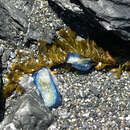en
names in breadcrumbs


The Velella is carnivorous but is also the prey of local mollusks. The violet slug, a common predator of the Velella, floats independently as it feeds on Velella. (Ricketts,et al 1997)(Russell-Hunter 1979)
US Federal List: no special status
CITES: no special status
The Velella velella is a carnivorous hydroid polyp, feeding on small prey and fish that can be caught only immediately below the surface of the water. The Velella is limited to surface food because it is not a very big animal and its tentacles do not reach very far. Its mouth is located in the middle of the underside of its body and lacks tentacles.(Russell-Hunter 1979, Nichols 1979)
The Velella is found floating on the surface of the high seas, and is common in the warm seas.
(Ricketts, et al 1997)
Biogeographic Regions: atlantic ocean (Native ); pacific ocean (Native )
This hydroid polyp remains afloat on the suface of the Pacific Ocean for most of its life. It never touches or even comes close to the ocean bottom, and the only stage in its life when it is completely submerged under water is the larval stage. The Velella velella begins its life in the middle of the Pacific Ocean, is brought by the wind to the shores, and is usually cast up on a beach where it dies and disentegrates. The Velella are most common on the high seas, in the warmer regions of the Southern and Northern Hemispheres.
(Russell-Hunter 1979)(Ricketts, et al 1997)
Aquatic Biomes: coastal
When taxonomists classified the Velella velella as a Siphonophore, it was consisdered to be a much smaller species then most which comprise the order. Although these animals are tiny, they were described as having a complex body structure just as any other Siphonophore. The Velella is sometimes mistakenly called a 2 cm "portuguese man-of-war" and has cellophane like floats and erect triangular sails. The invertebrate is described as an upside-down polyp of a hydrozoa which did not settle to the bottom and grow sessile, but instead settled on the surface of the water and grew a float. The Velella is blueish to purple with a flat oval transparent float and an erect sail projecting vertically at an angle to the axis of its body. The projection of the sail is so that the animal can take the best advange of the wind, at any given moment. Older zoological opinions thought the Velella was a colony of specialized individuals like the "man-of -war", and that beneath its disk there was a single large feeding polyp surrounded by many reproductive polyps and a fringe of stinging polyps. More recent studies, however, have classified the Velella velella as a highly modified individual hydroid polyp, and not a colonial hydrozoa. Older zoological opinions classified the Velella velella as a Siphonophore, along with the Portuguese man-of-war and other colonial creatures. In contrast, recent taxonomists have classified the animal as a Chondrophore along with two or three uncommon relatives.
Within the species of Velella, the offspring show polymorphism in the orientation of their sails. A portion of the progeny have sails located from left to right away from the parent, and others have the sail from right to left. Both forms of Velella velella commonly occur. It is hypothesized that the different forms of this marine animal are mixed in the middle of the Pacific Ocean as larva, and that wind and wave patterns during development and growth cause them to move towards the coast. (Each form sending them in opposite directions). Near the end of spring, and early summer they arrive on the shores and are commonly cast up on the beaches of the Northern and Southern Hemispere. The distribution of its dimorphic form also takes place in the Atlantic and the Mediterranean.
(Russell-Hunter 1979, Ricketts,et al 1997)
Other Physical Features: ectothermic ; radial symmetry
When biologists looked at the Velella velella as a colonial hydrozoan, the colonies were said to be hermaphroditic and the gonophores dioecious. The reproductive polyps were thought to produce medusa, which would break away from the colony and reproduce sexually, giving rise to planula larva. In recent studies, as biologist have examined the Velella as a single hydroid, reproduction still consists of an alternate generation between polyp and medusa stages. The life cycle: polyp-medusa-egg-planula-polyp.(Bayer and Harding 1968)(Ricketts, et al 1997)
Parental Investment: no parental involvement